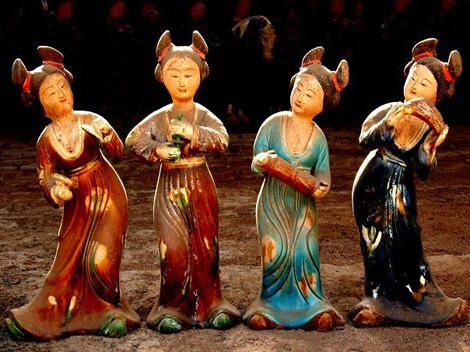As a colored pottery craft prevailing in the Tang Dynasty, Tang tricolor pottery takes yellow, brown, and green as its basic glaze colors, so it is named "Tang tricolor pottery" (Tangsancai). It is known for its vivid design, flamboyant color and luster, and rich life ambiance.

The images of the Tang tricolor pottery are rich and colorful. Generally speaking, they can be classified into several types: the first type is human figures, which are usually of high stature, some 70 or 80 centimeters, and some can reach as high as over 100 centimeters; the second type is the figures of animals, of which the horses and camels are the most eye-attracting; the third type is living utensils, the commonest of which are the utensils closely related to life, such as plates, bowls, kettles, bottles, etc; the fourth type is the models, which are used as articles to be buried with the dead.
Another feature of the Tang tricolor pottery is its color. The practice of applying simultaneously the three glaze colors - red, green and white – to the same article was initiated in the Tang Dynasty. The craftsmen skillfully employed the three colors and fired the pottery in high temperature. After the pottery come out of the kiln, it can take on a colorful appearance with the glaze colors intermingled in between.
As a traditional culture product and craft artwork, the Tang tricolor pottery not only has gained a significant status in the Chinese pottery history and the history of fine arts, but also plays an important role in the cultural exchanges between China and foreign countries. Both of the "tricolor pottery of Nara" in Japan and "tricolor pottery of Silla" in Korea are the crystallization of the Chinese pottery art. The Silk Road as well as some countries along the Mediterranean coasts and West Asia have witnessed the excavations of the relics of Tang tricolor potteries.
Tang tricolor pottery is also a real portrait of the social life of the Tang Dynasty during its prime time over one thousand years ago, which reflects the aesthetic value which attached great importance to the flamboyance and elegance of the attires and the plumpness of ladies. The images of strong horses, numerous camels, and the Tartars from West China indicate the prosperity of commerce and trade at that time. All these have helped us transcend time and space and get back to the time-honored flourishing Tang Dynasty of splendid civilization.





